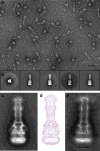Tripartite assembly of RND multidrug efflux pumps
- PMID: 26867482
- PMCID: PMC4754349
- DOI: 10.1038/ncomms10731
Tripartite assembly of RND multidrug efflux pumps
Abstract
Tripartite multidrug efflux systems of Gram-negative bacteria are composed of an inner membrane transporter, an outer membrane channel and a periplasmic adaptor protein. They are assumed to form ducts inside the periplasm facilitating drug exit across the outer membrane. Here we present the reconstitution of native Pseudomonas aeruginosa MexAB-OprM and Escherichia coli AcrAB-TolC tripartite Resistance Nodulation and cell Division (RND) efflux systems in a lipid nanodisc system. Single-particle analysis by electron microscopy reveals the inner and outer membrane protein components linked together via the periplasmic adaptor protein. This intrinsic ability of the native components to self-assemble also leads to the formation of a stable interspecies AcrA-MexB-TolC complex suggesting a common mechanism of tripartite assembly. Projection structures of all three complexes emphasize the role of the periplasmic adaptor protein as part of the exit duct with no physical interaction between the inner and outer membrane components.
Figures





Similar articles
-
Interactions underlying assembly of the Escherichia coli AcrAB-TolC multidrug efflux system.Mol Microbiol. 2004 Jul;53(2):697-706. doi: 10.1111/j.1365-2958.2004.04158.x. Mol Microbiol. 2004. PMID: 15228545
-
The C-terminal domain of AcrA is essential for the assembly and function of the multidrug efflux pump AcrAB-TolC.J Bacteriol. 2009 Jul;191(13):4365-71. doi: 10.1128/JB.00204-09. Epub 2009 May 1. J Bacteriol. 2009. PMID: 19411330 Free PMC article.
-
Fitting periplasmic membrane fusion proteins to inner membrane transporters: mutations that enable Escherichia coli AcrA to function with Pseudomonas aeruginosa MexB.J Bacteriol. 2008 Jan;190(2):691-8. doi: 10.1128/JB.01276-07. Epub 2007 Nov 16. J Bacteriol. 2008. PMID: 18024521 Free PMC article.
-
RND efflux pump mediated antibiotic resistance in Gram-negative bacteria Escherichia coli and Pseudomonas aeruginosa: a major issue worldwide.World J Microbiol Biotechnol. 2017 Feb;33(2):24. doi: 10.1007/s11274-016-2190-5. Epub 2017 Jan 2. World J Microbiol Biotechnol. 2017. PMID: 28044273 Review.
-
AcrAB and related multidrug efflux pumps of Escherichia coli.J Mol Microbiol Biotechnol. 2001 Apr;3(2):215-8. J Mol Microbiol Biotechnol. 2001. PMID: 11321576 Review.
Cited by
-
Mutations in the TolC Periplasmic Domain Affect Substrate Specificity of the AcrAB-TolC Pump.Front Mol Biosci. 2020 Jul 21;7:166. doi: 10.3389/fmolb.2020.00166. eCollection 2020. Front Mol Biosci. 2020. PMID: 32850959 Free PMC article.
-
Cool-contacts: Cryo-Electron Microscopy of Membrane Contact Sites and Their Components.Contact (Thousand Oaks). 2024 Feb 25;7:25152564241231364. doi: 10.1177/25152564241231364. eCollection 2024 Jan-Dec. Contact (Thousand Oaks). 2024. PMID: 38410695 Free PMC article. Review.
-
Molecular insights into the determinants of substrate specificity and efflux inhibition of the RND efflux pumps AcrB and AdeB.Microbiology (Reading). 2024 Feb;170(2):001438. doi: 10.1099/mic.0.001438. Microbiology (Reading). 2024. PMID: 38358391 Free PMC article. Review.
-
A "Drug Sweeping" State of the TriABC Triclosan Efflux Pump from Pseudomonas aeruginosa.Structure. 2021 Mar 4;29(3):261-274.e6. doi: 10.1016/j.str.2020.09.001. Epub 2020 Sep 22. Structure. 2021. PMID: 32966762 Free PMC article.
-
Detergent headgroups control TolC folding in vitro.Biophys J. 2023 Apr 4;122(7):1185-1197. doi: 10.1016/j.bpj.2023.02.007. Epub 2023 Feb 10. Biophys J. 2023. PMID: 36772796 Free PMC article.
References
Publication types
MeSH terms
Substances
LinkOut - more resources
Full Text Sources
Other Literature Sources
Molecular Biology Databases

